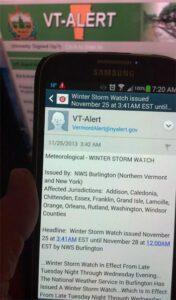 Alerts like this one, can be emailed, texted, and sent by other methods. Just sign-up at www.vtalert.gov[/caption]
Alerts like this one, can be emailed, texted, and sent by other methods. Just sign-up at www.vtalert.gov[/caption]
The Digital Economy Project was created to support the use of digital tools for disaster resilience. We’re always happy to see the State of Vermont take steps to use mobile technology, as well as email and social media to help spread the word about emergency information. With a new notification system being launched, the state has done just that. The Vermont Division of Emergency Management and Homeland Security (DEMHS) has officially launched its new notification system called Vermont Alert, or VTAlert for short. VTAlert provides Vermonters with information about risks and threats and helps them to respond accordingly. It is based on the belief that a major key to preparedness is having up-to-date information
There are two methods to get alerts from the system: you can go online here to sign-up for alerts, but when there is an event that is significant enough, messages are also sent through push alerts to text-enabled cell phones. So far, more than 4,060 people have already signed up for alerts through the system.
According to Robert Schell, VT Alert administrator at the DEMHS, “In this day and age of technology, it is our mission to harness the multiple ways we can now communicate and provide Vermonters with essential public safety information and the capability to be quickly notified when life threatening events do occur. VTALERT.GOV is designed to do just that, 24 hours a day.”
I wrote a blog about VTAlert back in July that you can read here. Mark Bosma, Public Information Officer from DEMHS, gave the additional details below:
What is VTAlert?
The system can issue alerts about pending disasters, weather conditions, traffic and road issues, public health notifications, and countless other issues or events that could affect Vermonters or their loved ones.
Vermont Alert (http://vtalert.gov) is a free service for users. It allows the public to sign up for and receive notifications through a number of delivery systems such as text, e-mail, telephone, or game console. Users will create accounts, chose their local area, select what types of alerts they wish to receive, and identify which delivery system they wish to use to receive those notifications.
Vermont Alert is hosted and maintained by the Vermont Division of Emergency Management and Homeland Security, but is available to emergency responders state-wide for use in alerting people in their local jurisdictions.
How can it be used?
VTALERT.GOV is a web-based system that provides a portal by which information can be disseminated by state and local authorities to the public, including schools and colleges, state, local, and federal government, and first responders.
There are many great examples of how VTAlert can be used in different scenarios:
Scenario #1: There is a large structure fire in a downtown.
The local fire department can write and distribute a press release through VT Alert. It can then contact the public directly with an evacuation notice (phone, text, or email), issue a travel alert for motorists to avoid the area, and alert the public of any public health hazards from smoke.
Scenario #2: A wildfire is burning.
Nearby towns can issue evacuation orders and notify residents in the affected area directly (via phone, text, or email). Press releases can be written and distributed through Vermont Alert, and the National Weather Service can issue an Air Quality warning if the fire warrants such a notification.
Scenario #3: An accident on Interstate-91 is blocking the road.
The State Police can write and distribute a press release regarding the accident. The Agency of Transportation can issue a travel advisory and outline alternate routes. VTrans can then notify the public when the road has re-opened.
Scenario #4: A tropical storm is occurring in Vermont.
In the state Emergency Operations Center, VT DEMHS and partners can use VTAlert to post alerts and updates, including Emergency Alert System messages, press releases, and special notifications regarding conditions, state road closures, health alerts, and locations of emergency shelters. VTAlert can then auto-populate social media with any of this information, and re-post National Weather Service storm watches and warnings. At the same time, local communities can also issue evacuation warnings and post local road closures and public health alerts through the system. In the aftermath of the storm, the state and federal government can post notifications about disaster aid to individuals and communities.
Towns can issue their own alerts
Several towns and organizations are currently developing plans to implement VTALERT.GOV, including the towns of Duxbury, Stowe, and Bennington, state agencies such as the Department of Buildings and General Services and the Department of Public Safety, and federal agencies, including the American Red Cross.
Municipalities and emergency response organizations can now receive training on the system in order to issue their own notifications to their members or the general public.
